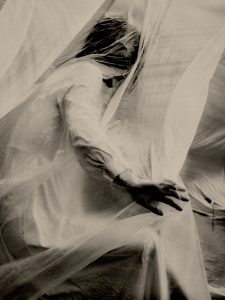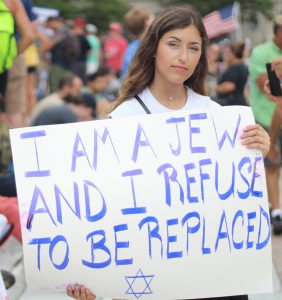Bearings
May Their Memory Be a Blessing
By Joan Latchaw
November 2018 Issue

It was a damp and windy February day in 1991 when I walked those few solemn blocks. With trepidation I swung open the heavy door and for the first time entered a beautiful but cavernous space. As I slowly made my way down the aisle, about twelve men, some quite elderly, approached me with great chesed, loving-kindness. I immediately burst into tears, and before I could utter a word—they knew. I had lost a parent. For the next six months I was a “regular” at the Tree of Life morning minyan.
It is a long-held and deeply felt tradition to say Kaddish, the mourning prayer, for eleven months after the death of a parent or child. Even Allen Ginsberg, who had little interest in Jewish law or ritual, wrote his famous poem, “Kaddish,” to commemorate his mother’s passing. The translation is surprising, as the words make no mention of death. Rather, the entire prayer is in praise of G-d, ending with a plea for peace, “for us and for all Israel.”
However, it is the intonation, the chant, the emphasis on the first four Hebrew words, “yitgadal v’yitkadash sh’mei raba,” that carry the emotional weight for mourners. The English is, “May His great Name grow exalted and sanctified,” but the felt experience is entirely lost in translation. The Kaddish is in our collective bones as Jews, perhaps dating from the time of Jacob, though the oldest version is found in the prayer book of a rabbi in the 9th century. Over a thousand years of tradition were echoed at the funerals of the eleven Jewish men and women who were shot and killed at the Tree of Life Shabbat services on October 27, 2018.
Over a thousand years of tradition were echoed at the funerals of the eleven Jewish men and women who were shot and killed at the Tree of Life Shabbat services on October 27, 2018.
In Judaism every life is regarded as sacred, from the humblest to the most revered. So it was not surprising that a group of Pittsburgh Steelers attended the funeral of “the boys,” Cecil and David Rosenthal, brothers with intellectual disabilities, who delighted synagogue goers on Shabbat mornings with their greetings and friendly quips. In Talmudic writings and philosophy, chesed shel emet or true loving-kindness is the ultimate mitzvah, as it confers dignity on the deceased and reflects actions that cannot be reciprocated. Honor and dignity are bestowed equally regardless of status, gender, or religiosity. For this reason, Judaism advocates burial in a plain pine box, after the tahara, the ritual washing and clothing of the body in shrouds. Even in death the body is considered sacred. All of it. This means that in times of war or violent crimes, like the slaughter of the eleven Tree of Life victims, teams must be dispatched to collect all remains, even blood—the life force—for inclusion in the grave.
So, I wasn’t surprised that the Pittsburgh Jewish community immediately responded to this need. Shira Telushkin, in an article in the Jewish magazine, Tablet, entitled, “Their Bloods Cry Out from the Ground,” poignantly reports that the local Squirrel Hill chevra kadisha, the Jewish burial society, refused outside help: “Pittsburgh Jews are prepared to bury their own dead.” One of these eight men told Telushkin that “when he is working with a dead body, he can feel the soul still hovering, watching as he does his work. He sees it as his job . . . to ease its journey on to the next world.”
Even in death the body is considered sacred. All of it.
 Reading these words, I saw myself cocooned in a small room, “guarding” the deceased bodies in a Minneapolis funeral home. My husband and I were part of the newly created Chevra Kavod Ha’met at the Adath Jeshurun Synagogue in 1975. He participated in tahara, and I became a shomer, a guard. Space and time were erased as Minneapolis and Pittsburgh bled into a single community. I was heartened to read about the Google doc call for volunteers to sit guard with the bodies. Forty people answered that call, and so dignity was bestowed as Jewish ritual requires.
Reading these words, I saw myself cocooned in a small room, “guarding” the deceased bodies in a Minneapolis funeral home. My husband and I were part of the newly created Chevra Kavod Ha’met at the Adath Jeshurun Synagogue in 1975. He participated in tahara, and I became a shomer, a guard. Space and time were erased as Minneapolis and Pittsburgh bled into a single community. I was heartened to read about the Google doc call for volunteers to sit guard with the bodies. Forty people answered that call, and so dignity was bestowed as Jewish ritual requires.
Some, such as Telushkin, have referenced “the blood of the Jewish martyr,” in relation to the Tree of Life victims and the righteous who died centuries ago for the sanctification of G-d’s name. Judaism is not big on martyrdom. But remembrance, zikkaron, is obligatory. One section of the High Holiday service for Rosh Hashanah, the beginning of the Jewish year, is called Zikhronot, remembrances. These verses recall G-d’s covenant, the promise to Abraham and Noah and all their descendants. They link the generations, one to the other. Remembrance is celebrated in Jewish communities. For this reason, the Kaddish cannot be recited alone; at least ten people are required. Back in 1991, I was enveloped, supported, and comforted—cocooned with those ten men, the microcosm of a larger community.
However, the concept of a Jewish community is in many ways elusive. Some Jews identify with religious groups, though these are in waning numbers. Others identify mainly with the State of Israel. Many find commonality in Jewish culture with food (lox and bagels, latkes, chicken soup); Klezmer bands or the rap music of Matisyahu and Shyne; comedians, such as Milton Berle, the bawdy Belle Barth, Joan Rivers, or Jerry Seinfeld; filmmakers Mel Brooks, Nancy Meyers, or Zack Braff; or lawyers and judges, such as Supreme Court justice Louis Brandeis, Ruth Bader Ginsberg, Elena Kagan, and Richard Cohen of the Southern Poverty Law Center that legislates against hate crimes. But the primary factor in formation of a Jewish identity, according to a 2013 Pew Research Center study, is the Holocaust.
That fact was not lost on the international Jewish community, however it may be defined. Indeed, it struck me as a tragic irony when I first heard that Rose Mallinger, the 97 year-old Holocaust survivor, was not exterminated in a crematorium by a Nazi, but shot with an AR-15-style assault rifle in a synagogue by an American. This biographical detail resonated deeply with me, a war baby whose psychic life has been shadowed by the specter of skeletal bodies, museum exhibits of battered leather suitcases and shoes of all sizes and shapes, and the writings of Anne Frank, CynthiaOzick, Primo Levi, Elie Wiesel, Art Spiegelman, and Bernhard Schlink.
Back in the 1980s, as an MFA student at the University of Pittsburgh, I wrote a poem dedicated to Carolyn Forché, an activist who spent a year in El Salvador witnessing horrendous atrocities, which shaped a bestselling volume of poetry, The Country Between Us. Connecting to the trauma of her witness to the brutality of the civil war, I wrote:
We are bound
in a timeless slaughterhouse
I, with my Polish stockcars,
You, with your burning amarradoes,
those links of rope slowly tightening
around our swollen wrists.
In reality, those were not my stockcars, as I personally lost no one in the Holocaust. Neither were my recurring dreams a living nightmare drawn from my own experience: dying in a concentration camp and being reincarnated into a Jewish American family. But perhaps neither are they untrue. Indeed, today I’m asking myself, “What constitutes the truth?” Because while checking out sources for this reflection, I discovered that Rose Mallinger was not a survivor of the Holocaust, as had been widely reported in the aftermath of the Tree of Life massacre. From October 28 to November 2, newspapers and blogs corrected the error.
The truth is that all Jews own a common heritage of loss from the ovens of Germany and Eastern Europe. It is a fact, too, that we survived.
The claims about Rose and my poetic sentiments are clearly inaccuracies. But the truth is that all Jews own a common heritage of loss from the ovens of Germany and Eastern Europe. It is a fact, too, that we survived.
It is also a fact that the Pittsburgh synagogue is named “Tree of Life.” It is a phrase that derives from the prayer, Etz Khayim, recited every time the Torah is returned to the ark. It is a belief that the “tree of life” is a metaphor for the Torah scroll and that, as the prayer says, the Torah’s “ways are ways of pleasantness, and all its paths are peace.”
Perhaps peace can prevail, if we remember Deuteronomy 16:20, which commands, “Justice, justice you shall pursue.” Rabbi Tarfon, who lived into the second century of the Common Era, expressed this idea in the phrase Tikkun Olam, known as “repair of the world.” One of his most well-known maxims is, “You are not obligated to complete the work. But neither are you permitted to abandon it.” Judaism, as many of us are taught, is a religion founded on action. Hopefully, belief will follow.
 Action is born of remembrance. We must remember that the great Jewish theologian, Abraham Joshua Heschel, marched with the great preacher and activist Martin Luther King, Jr. in 1963. We must remember that, just last year, Muslim communities raised close to $200,000 and physically labored to restore headstones vandalized in Philadelphia’s and St. Louis’s Jewish cemeteries. We must remember that our country commemorated the 26 killed at the First Baptist Church in Sutherland Springs, Texas in 2017. These actions are living proof that people are capable of going “from strength to strength,” a phrase commonly spoken to the bereaved. We sang "Amazing Grace" along with President Obama at the memorial for the nine members of Emanuel African Methodist Episcopal Church in downtown Charleston, South Carolina, on June 17, 2015. We stood with Sikhs across the country after the killing of six people in Oak Creek, Wisconsin on August 5, 2012.
Action is born of remembrance. We must remember that the great Jewish theologian, Abraham Joshua Heschel, marched with the great preacher and activist Martin Luther King, Jr. in 1963. We must remember that, just last year, Muslim communities raised close to $200,000 and physically labored to restore headstones vandalized in Philadelphia’s and St. Louis’s Jewish cemeteries. We must remember that our country commemorated the 26 killed at the First Baptist Church in Sutherland Springs, Texas in 2017. These actions are living proof that people are capable of going “from strength to strength,” a phrase commonly spoken to the bereaved. We sang "Amazing Grace" along with President Obama at the memorial for the nine members of Emanuel African Methodist Episcopal Church in downtown Charleston, South Carolina, on June 17, 2015. We stood with Sikhs across the country after the killing of six people in Oak Creek, Wisconsin on August 5, 2012.
But even with memory nudging our conscience and the winds of justice at our backs, action is difficult to sustain, especially with persistent acts of violence. Within a week of the Pittsburgh murders, ten anti-Semitic incidents were reported: seven fires in Brooklyn synagogues and yeshivot, and a Nazi-inspired graffiti reading, “Die Jew Rats” resulted in the cancellation of a get-out-the-vote event. A California synagogue, likewise, was sprayed with anti-Semitic graffiti. The list goes on and on, and it certainly didn’t start with the Tree of Life killings.
Against such hate, we need an ever-flowing stream of inspiration. Some will derive inspiration from scripture, attending perhaps to the concept of restorative justice Paul describes in his letter to the Romans. Some will be energized by iconic images, like the raised fist inside a Star of David or one overlaid with the brightly colored words, “Never Again.” These images are now printed on T-shirts, hoodies, and even tattoos. Some people will take inspiration from Hatikvah (Hebrew for “The Hope”), the poem that became the Israeli national anthem. Maybe folks from my generation will feel the heart of John Lennon, as he imagines “all the people living a life in peace.” Maybe younger people will vibe to “Holy War,” by Alicia Keys, “so we can heal each other and fill each other… break these walls between each other.”
Whatever it takes, I pray that we may all find our way, individually and as a community, to ensure the survival of humankind for generations to come. Tikkun Olam.
Photo Credits:
Cover Photo: Andy Hall, “Paper Lanterns”(December 27, 2017). Via Unsplash. CC2.0 license. Text added.
Body Photo #1: Veliza Ivanov, "Earth Opacity" (January 5, 2018). Via Unsplash. CC2.0 license. Tinted.
Body Photo #2: Melany Rochester, "Unite the Right 2 Counter Protests 8.12.18," (August 13, 2018). Via Unsplash. CC2.0 license. Cropped.

